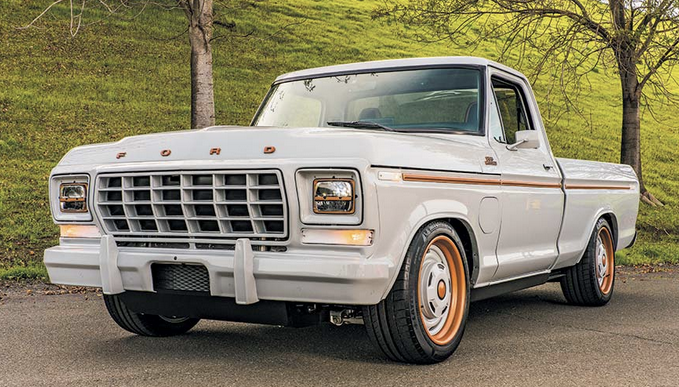Zack's Website
My Egotistic and Esoteric Website
1973 Ford F100 Truck

I picked up this truck at an auction. More info on its "restoration" will be forthcoming, but note that I'm not going to do much to it. Just make sure it's safe to make a hardware store run, take the race car out to the local track and stuff like that. It's not going to be a daily driver by any means. I'll post my progress, but as far as its vital statistics, rumor has it, in the late 1980's Ford was doing some housecleaning and planned to throw away all the VIN-specific data, production figures, etc. for all the '60s and '70s-era cars and light trucks. I was able to glean the following information and it also matches the original purchase receipt I found in the glove box!
More historical information about the 1973 Ford F-100 Model at the bottom of the page if you're interested.
- 1973 Ford F100 2-Wheel Drive "Long Bed"
- Ford 360 V-8 Engine with 3-Speed Automatic (Transmission Code G)
- Color Code: S - Dark Blue Metallic (Midnight Blue Metallic)
- Body Code: 99 - Custom Cab with Styleside Trim Package
- Light Blue and Medium Blue Vinyl Interior
- Body Style: F102 - 133-inch Wheelbase (4800 GVWR)
- 3.00 Ratio 3.3M Ford Rear Axle (Axle Code: 02J)
- 1 of 457,746 made
- Made/Assembled in Allen Park, Michigan (Pilot Plant)
- Original Owner Added the Following Options
- Power Steering
- AM Radio
- Rear Step Bumper with Towing Ball
- JRWC Stainless Steel Mirrors ($45.00)
- Undercoat ($65.00)
- Total "Out the Door" Price (incl. Tax/Title/etc) was $3,362.80!
The truck runs and drives, but has soft brakes. (That was fun getting it off the trailer.) I've had to get a couple of older extra Ford keys made. Some of the interior/dash/instruments are really nice, some of the dash isn't, like the vinyl has cracked (this is more than 50 years old, remember) so it need a little "resto-mod" help.
Here is it running....
First thing to do is an oil change, filter (both oil and fuel) replacement, rear brakes (shoes, drums, wheel cylinders), front brakes (pads and rotors), master cylinder replacement and engine belts. Other than that, I'll tackle what I can when I can.
More progress forthcoming....
For those that were interested, here's a copy of the dealer order write-up/sales slip. To
protect the innocent, I've blacked out his name, address, and phone number (if by some
miracle he's still alive) - but I doubt it. To protect me, I've blacked out the VIN and
ignition key code (so you can't go to a locksmith and get keys made) and steal it off my lawn!
Interestingly enough, this style key/ignition was made from the 60's to the 90's
according to my locksmith. I just gave him the code on this paperwork and he was able
to create keys for me. It was kind of neat/scary too!
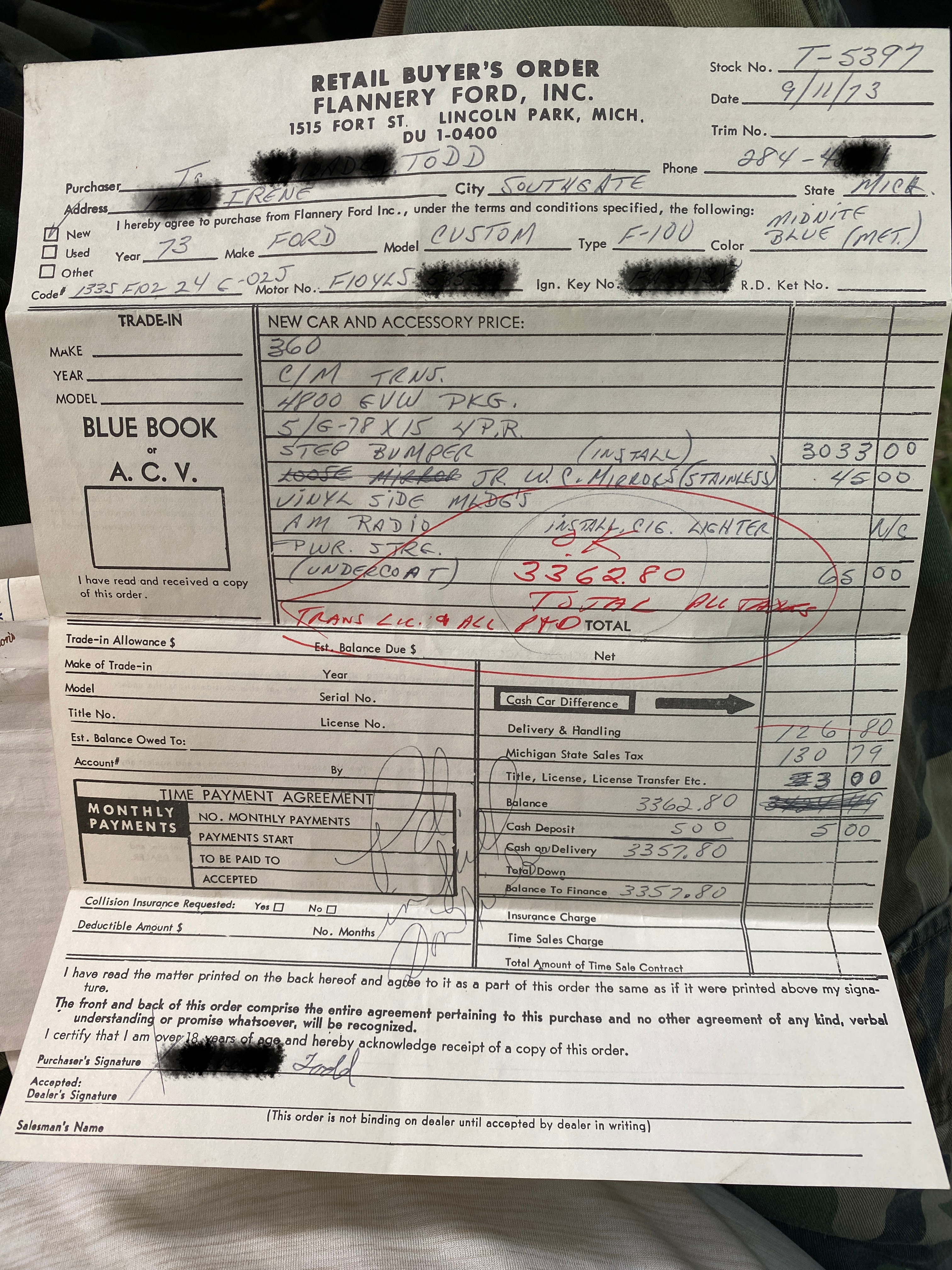
Oh, and I have to get a set of new tires. As you can tell from the photo those are a
little different that what originally shipped with those trucks from the 1960's and 1970's.
Remember those?
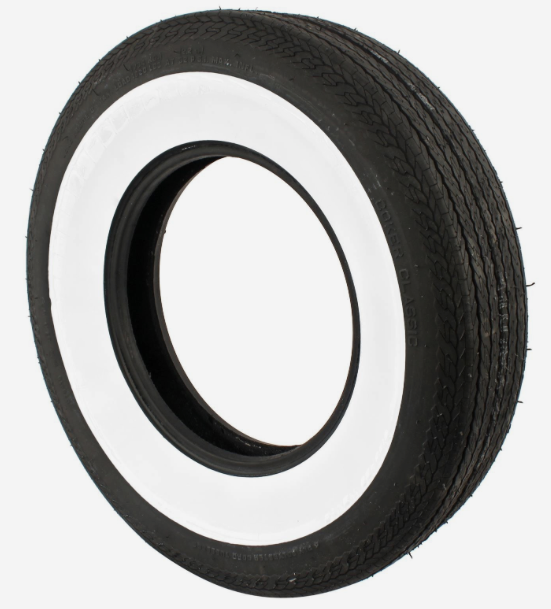
I had to perform a little conversion since the old G78-15 tires (reminds me of the movie
My Cousin Vinny) just aren't available at your local Midas! Sure you can get those
old white-walled looking tires, but they are more than $250.00 per tire. Not going
to do that! I'll just stick some P215/74R15's on there and call it a day. I'm not
going to put oversized tires or jack up the truck. I'll keep it stock looking.
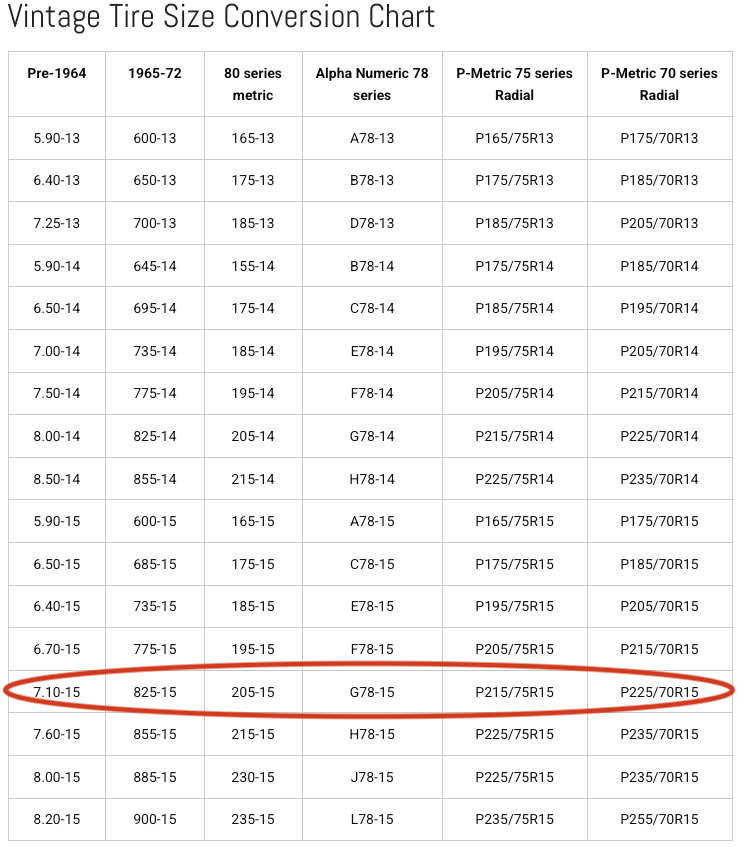
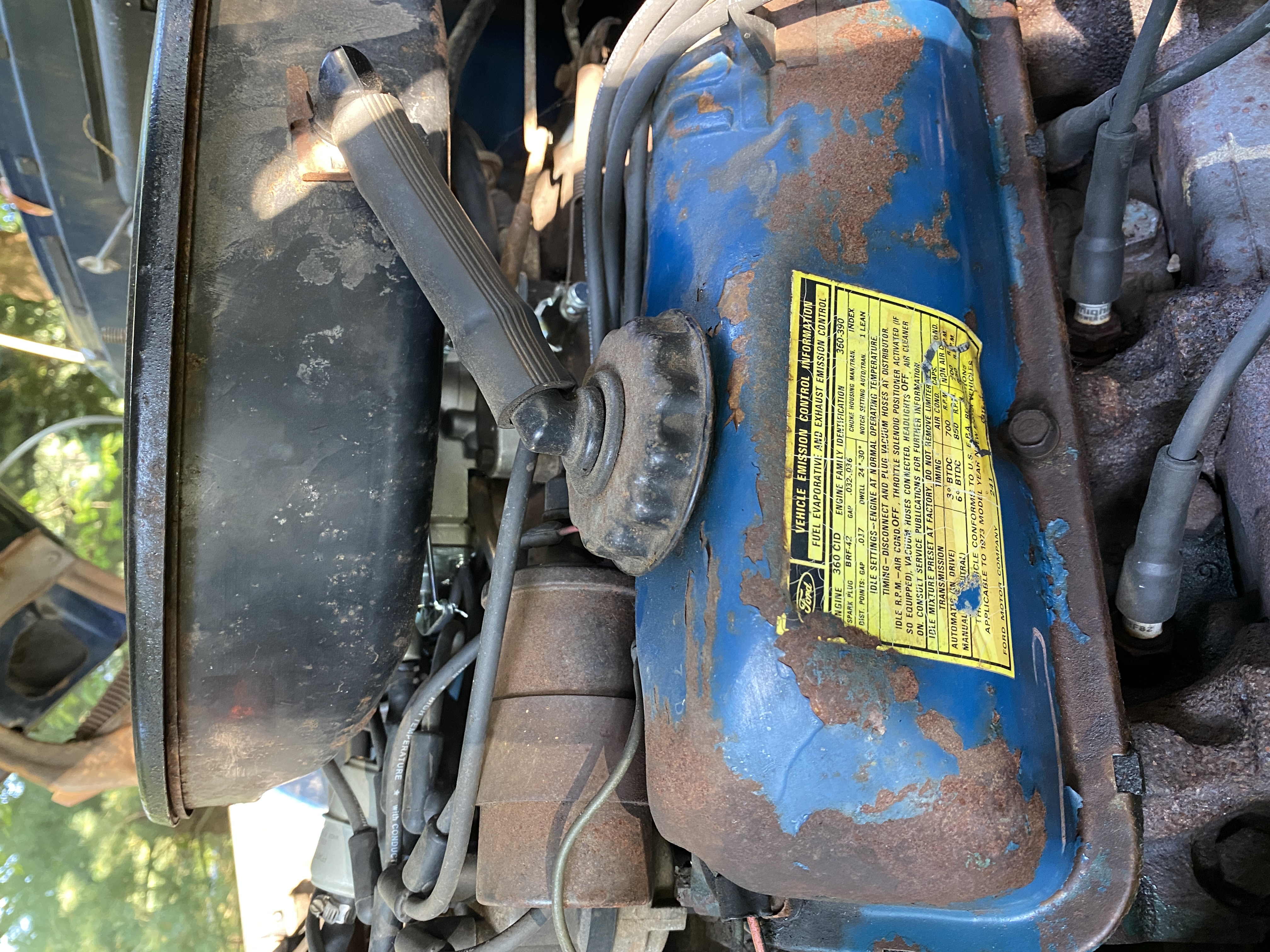
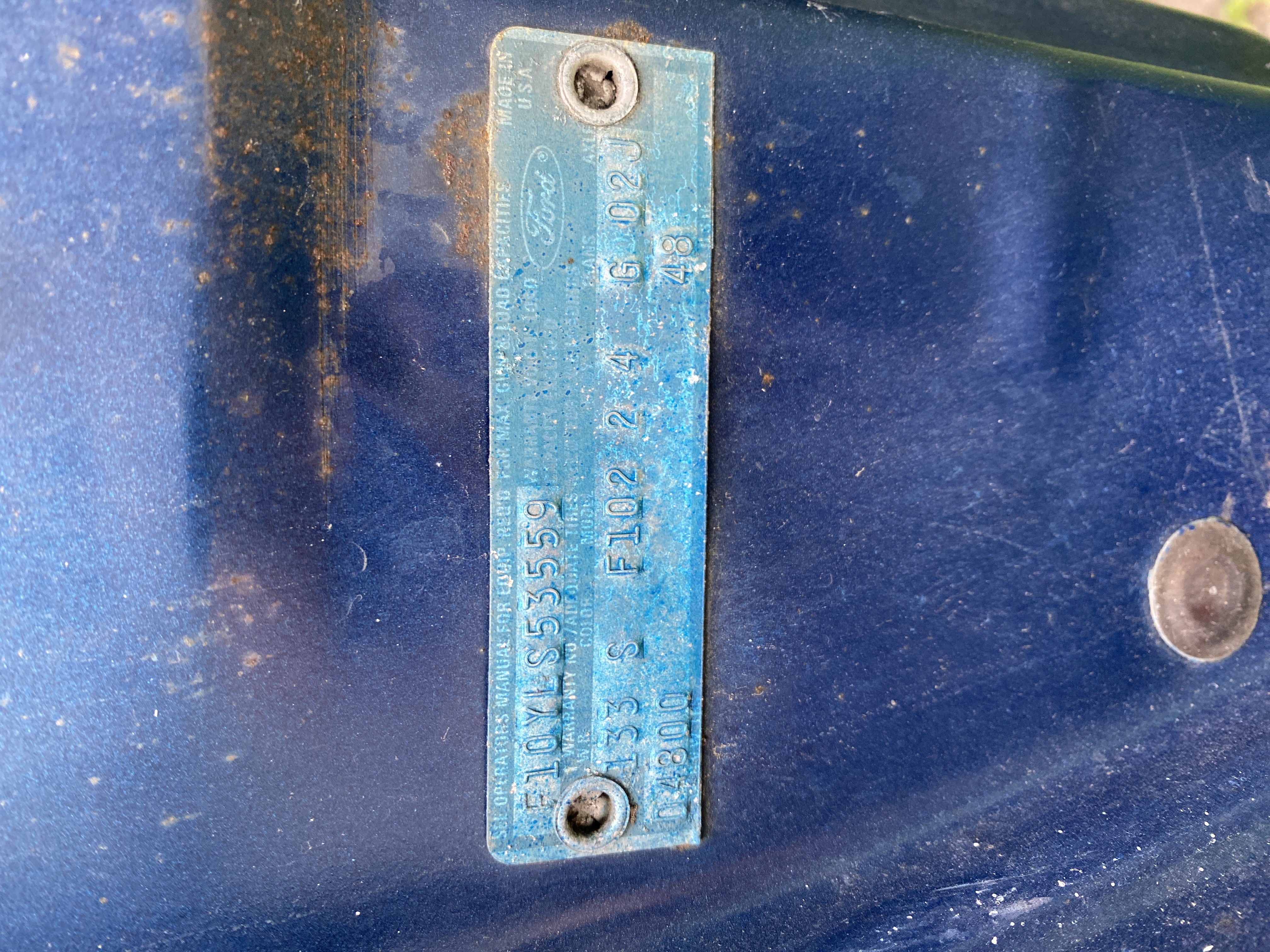
Overview of Ford Trucks (1973-1979)
From 1973 to 1979, Ford continued to lead the automotive market with significant advancements in its F-Series trucks. This era introduced the sixth generation of the F-Series, which brought robust designs, enhanced performance, and improved comfort. These vehicles set new standards in the industry, reflecting Ford's commitment to innovation, quality, and customer satisfaction. With stronger frames, more powerful engines, and enhanced features, the F-Series trucks from this period not only met the demands of their time but also laid the groundwork for future developments.
During the 1973-1979 period, Ford introduced and refined several key models within its F-Series lineup. Each vehicle was designed to meet specific user requirements, ranging from everyday driving to heavy-duty commercial use and off-road adventures.
You could order pretty much any engine configuration you wanted. For example,
- 240 (3.9L) or 300 CID (4.9L) Inline-Six: Known for its durability and torque, this engine was a staple in the F-100 and F-150 models. It provided reliable performance and was particularly favored for its balance of power and fuel efficiency, making it ideal for daily driving and light-duty tasks. The 300 CID engine produced around 115-120 horsepower and 260-265 lb-ft of torque.
- 302 CID (4.9L) V8: Offered as an option in both the F-Series trucks and the Bronco, the 302 V8 provided more power while maintaining good fuel efficiency. It delivered approximately 130-140 horsepower and 230-240 lb-ft of torque, making it a versatile choice for those needing a bit more performance without sacrificing efficiency.
- 360 CID (5.9L) V8: The 360 V8 engines were known for their higher horsepower and torque, suitable for more demanding tasks. The 360 produced about 150-160 horsepower and 280-290 lb-ft of torque.
- 390 CID (6.4L) V8: This larger V8 engine was available in the F-250 and F-350 models, providing substantial power for heavy-duty applications such as towing and hauling. It produced around 170-180 horsepower and 300-310 lb-ft of torque, making it well-suited for commercial use and heavy lifting.
- 460 CID (7.5L) V8: The largest engine in the lineup, the 460 V8, was also available in the F-250 and F-350 models. It delivered significant power and torque, with outputs around 200-220 horsepower and 380-400 lb-ft of torque. This engine was ideal for the most demanding tasks, offering exceptional performance for heavy-duty applications.
And several Transmissions were available also. For example,
- 3-Speed Manual: This was the standard transmission on many of the models during this period. Known for its simplicity and reliability, the 3-speed manual offered basic control and was commonly paired with the smaller engines.
- 4-Speed Manual: Available for the heavier-duty models, the 4-speed manual transmission provided better control and gearing for towing and hauling. It was often paired with the larger V8 engines to handle increased torque and power.
- C6 3-Speed Automatic: One of Ford's most durable and popular transmissions, the C6 3-speed automatic was available across the lineup, especially in the heavier models. Known for its strength and reliability, the C6 provided a smooth driving experience and was capable of handling the high torque output from the larger engines. Ever hear someone say "Three On the Tree"? This means it was a 3-Speed Transmission on the Steering Wheel column.
Throughout the 1973-1979 period, Ford introduced several special models and significant yearly changes to the F-Series lineups. These enhancements reflected Ford's responsiveness to market demands and its commitment to innovation, resulting in vehicles that offered improved performance, comfort, and versatility. For example, in 1975, Ford introduced the F-150, positioned between the F-100 and F-250. This model was developed in response to new emissions regulations and offered a higher gross vehicle weight rating (GVWR) without requiring heavy-duty emissions controls. The F-150 quickly became one of the best-selling trucks in the lineup due to its versatile payload capacity and broad appeal.
The 1973 model year (sixth generation) of the F-Series was introduced in 1973, featuring a more robust and modern design. This redesign included stronger frames and increased payload capacities. The new models also incorporated improved aerodynamics and a more comfortable cabin, setting new standards for the truck market.
In 1975, enter the government and everythign you loved about cars started to die off. Over-reaching government regulation from democratic leaders started to take over and you ended up with the introduction of Catalytic Converters. In response to new emissions regulations, Ford began equipping its trucks with catalytic converters in 1975. This change marked a significant step towards reducing vehicle emissions.
Ford also introduced more efficient carburetors, such as the Motorcraft 2150 and 4350 models, which provided better fuel atomization and improved engine performance. These carburetors helped enhance throttle response, fuel economy, and overall drivability.
By the mid-1970s, factory-installed air conditioning became increasingly common in the F-Series. This feature significantly improved cabin comfort, particularly in warmer climates, making these vehicles more appealing for everyday use and long-distance travel. Power windows and door locks also became options on higher trim levels, such as the F-150 Ranger XLT. These features added convenience and a touch of luxury, enhancing the overall driving experience. To improve driver comfort and ergonomics, Ford introduced the tilt steering wheel option. This feature allowed drivers to adjust the steering wheel angle to their preferred position, reducing fatigue during long drives.
Power steering became a standard feature or widely available option across the F-Series. This technology made steering easier, especially at low speeds or when maneuvering with heavy loads, improving overall vehicle control and driver comfort. Power brakes were introduced to enhance braking performance, particularly important for trucks that frequently carried heavy loads or towed trailers. This feature reduced the effort required to apply the brakes, increasing safety and driver confidence. Advanced suspension systems to improve ride quality and handling were introduced. The Twin I-Beam front suspension, introduced in 1965, continued to be used in the F-100 and F-150 models, providing a smoother ride and better handling on rough surfaces. Four-wheel-drive F-Series models featured improved four-wheel-drive systems, enhancing their off-road performance. These systems included better transfer cases and locking hubs, making it easier to switch between two-wheel and four-wheel drive, thus providing superior traction in various driving conditions.
The design principles and innovations introduced in the 1973-1979 period laid the groundwork for the continued success of the F-Series. The F-150, in particular, has remained a best-seller for decades, continually evolving while retaining the core attributes that made it popular. The Bronco's legacy also endures, with the recent reintroduction of the model drawing heavily on its historical design and off-road capabilities.
The success and popularity of the F-Series set high standards that competitors have continually aimed to match. The features and capabilities introduced by Ford during this period often set trends that shaped the broader market, pushing the entire industry towards higher standards of performance, safety, and comfort.
The Ford F-100 trucks still have a huge following. So much so, that at an annual SEMA convention, Ford made an
all electric concept truck. Cool, eh?
